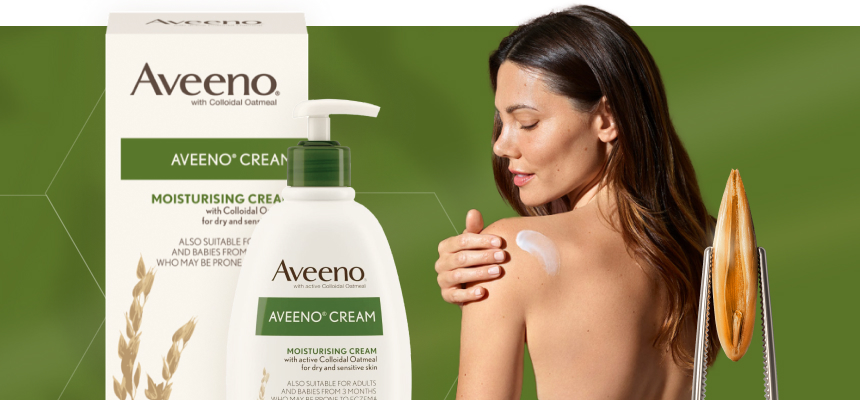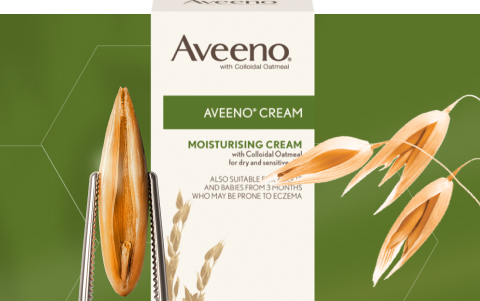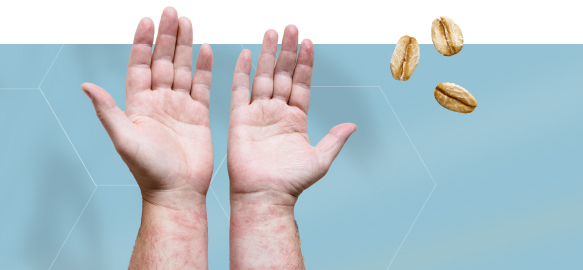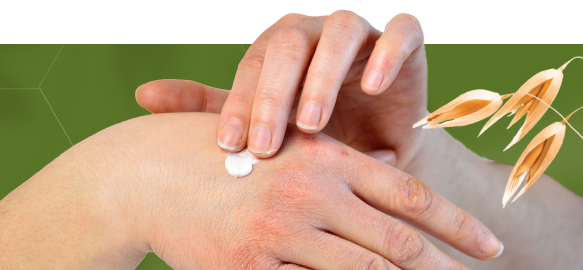Aveeno® Cream can be applied liberally to dry, sensitive skin as often as required. We recommend that users smooth the cream into the skin along the line of hair growth, rather than rubbing it in.

1 in 10 adults suffer from eczema in the UK1. Consequently, this common skin condition is responsible for 22.5% of all dermatological consultations2, with the NHS spending £125 million every year on eczema management alone3.
That’s why giving patients the correct emollient prescription to meet their needs is of extreme importance4.
Prescribing AVEENO® first for patients with eczema has been proven to achieve long-term savings, by cutting down on appointments and lowering subsequent antimicrobial and corticosteroid prescription costs5.
*Mean cost per patient £140.35 with AVEENO® first vs £206.43 when switching to AVEENO® later (p<0.0001).
  |
Eczema – or atopic dermatitis – is an inflammatory skin condition, characterised by itchy, dry skin that can be prone to infection. It’s a chronic condition, which means there is no cure. But it can be managed by protecting the skin barrier and reducing inflammation when flare-ups occur5,6. |
|
While the exact cause of eczema is unknown, there are ways to manage the symptoms7. NICE recommend using a stepped approach, including the continual daily use of emollients to help restore and protect the skin barrier – even when the skin is clear8. |
|
Consistent use and compliance is key for managing eczema effectively9. So, just make sure the emollient offered matches your patient’s needs and preferences3.
Aveeno® Cream is a skincare product, formulated with colloidal oatmeal to actively moisturise dry and sensitive skin. The cream is suitable for both adults and babies from as young as 3 months who may be prone to eczema.
  |
Aveeno® Cream products have a range of benefits:

Actively moisturises dry and sensitive skin - suitable for sensitive skin.

Regular use hydrates the skin - leaving it feeling comfortable, soft and smooth.

Fragrance-free - does not contain perfumes that might be irritating to sensitive skin.

Formulated with finely processed oatmeal
- to help restore the skin’s natural barrier.

Suitable for adults and babies from 3 months - including those who may be prone to eczema.

Aveeno® Cream can be applied liberally to dry, sensitive skin as often as required. We recommend that users smooth the cream into the skin along the line of hair growth, rather than rubbing it in.
NICE guidelines recommend that you refer patients under 12 to a dermatologist if:

They exhibit severe or bacterially infected atopic eczema that has failed to respond to optimal topical therapy after one week8.

Management techniques have failed to control the atopic eczema to the patient or carer's satisfaction, based on a subjective assessment8.

There is an uncertain diagnosis or possibility of contact dermatitis is suspected8.

The atopic eczema is causing significant psychological or social problems for the patient or carer8.

The patient or carer can benefit from specialist dermatological advice on treatment and its application8.
You should refer your atopic eczema patients to a relevant specialist if:
- They are responding to optimal management but their wellbeing has not improved8.
- They have a suspected food allergy8.
- They are a child that fails to grow at the expected trajectory8.
Please refer to NICE guidance for further information.
Make the most of the eczema resources and training available on Academy+.

Find out more about eczema or atopic dermatitis, including symptoms and causes of eczema flare ups. Learn about the different treatment and management options for people with eczema-prone skin.
Learn about eczema >

As one of the major signs of eczema, treating dry skin is an important part of the eczema management and training process. Take our training to learn more about dry skin and its subsequent effects.
View our dry skin training >
1. Eczema- atopic. How common is it? NICE Clinical Knowledge Summary April 2023 https://cks.nice.org.uk/topics/eczema-atopic/background-information/prevalence/. Accessed September 2023.
2. Kerr OA et al. Clin Exp Dermatol 2009;35:380-83
3. Emollients. NICE April 2023. https://cks.nice.org.uk/topics/eczema-atopic/prescribing-information/emollients/. Accessed September 2023.
4. Moncrieff G et al. BMC Dermatology 2018;18:9.
5. Cork MJ et al. J Dermatolog Treat 2020; 31(8): 801-809.
6. Atopic eczema. NHS. December 2019. https://www.nhs.uk/conditions/atopic-eczema/. Accessed September 2023.
7. Eczema (atopic). nidirect. https://www.nidirect.gov.uk/conditions/eczema-atopic. Accessed September 2023.
8. Atopic eczema in under 12s: diagnosis and management. https://www.nice.org.uk/guidance/cg57/chapter/Recommendations. Accessed September 2023.
9. Eczema: atopic eczema. Primary Care Dermatology Society. July 2023. https://www.pcds.org.uk/clinical-guidance/atopic-eczema. Accessed September 2023.
Date of preparation: July 2023
UK-ACA-2300366